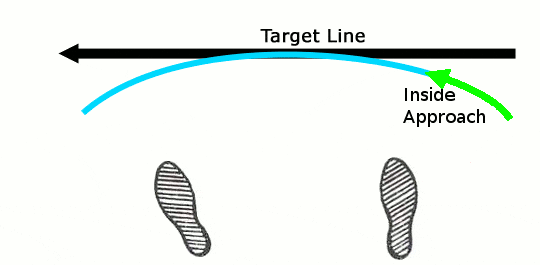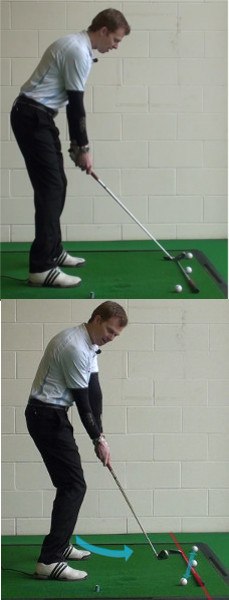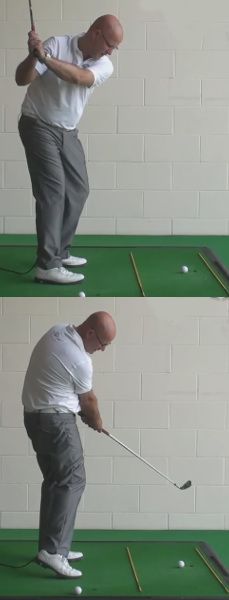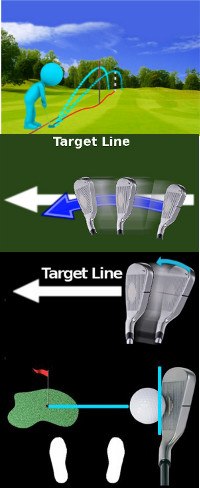
Learn about an 'in to out' swing path and how it can improve your golf with this golf tip.
For a right handed golfer an 'inside' swing path is when the golf club head passes through the golf ball on a line from left to right rather than straight towards the target. This is termed an 'in to out swing' or swinging from the 'inside'. These directions are all reversed for left handed golfers.
A golfer should swing through the golf ball on a 'inside' swing path to gain more distance and hit the golf ball straighter:
Distance - An inside path of the golf club means that the golf club head travels into the golf ball from behind the body and at a shallow angle into the golf ball. More distance occurs from this path as the club head rotates faster around the body when swinging into the golf ball on this line. Also, because the club is rotating in a circular motion around the body, the hands can work faster through the ball by rotating over one another and letting the club head overtake the hands, promoting huge speed into the ball.
Accuracy - If the club head swings into the ball on an 'inside' path, the hands can rotate freely through the impact area turning the club face and allowing it to point directly at the target (also known as 'square') on contact with the ball. With the club face straight at impact, the golf ball is directed forwards towards the target.
There are two points to gaining an 'inside to out' swing path:
1. During the backswing, imagine that the club head creates a circle around the body as it swings. Ideally, the club head would travel underneath that circle during the downswing. To achieve this for a right handed golfer, the right hand needs to drop down to the right hip from the top of the backswing before swinging into the golf ball. This action drops the hands underneath the upward swing circle and swings the golf club into the ball from the correct 'inside' line. A good thought is one of putting the right hand in the right trouser pocket from the top of the downswing.
2. The second point is to keep the club head on line through the ball. The golf club needs to approach the ball from behind the body on it's way into the ball. Try to do this visually using a golf club on the floor. For right handed golfers, position the golf club approximately four inches outside the line of the golf ball (above it) and pointing to the right of the target by about 20 yards. Once the golf club is set on the floor, correctly set up on line with the target as normal. When swinging, make sure to swing the club head down the line of the golf club to the right of the target. This helps to visualize hitting the ball out to the right which creates an 'inside' motion of the golf club approaching the golf ball on the correct angle. To achieve this, make sure that the hands pass close to the back trouser pocket before swinging into the ball. If this happens, the club should swing on the 'inside' and the ball should travel out to the right of the target.
Once the club head is swinging into the ball on the 'inside' line, rotate the hands through the ball to turn the club face and curve the ball back to the target creating a right to left 'draw' shot.
Use this drill to swing into the ball straighter and faster for more accurate, longer shots.

How to Create Inside to Outside Swing Path
If there is one thing that most amateur golfers would love to be able to do on the course above all else, it is draw the golf ball. Producing a consistent, reliable draw is a task that seems to be difficult for many average golfers to accomplish – yet it is easy for any pro. So what is the difference? Why are professional golfers able to hit a draw with ease, yet most amateurs struggle with the task? It all comes down to swing path,. If you can deliver the club into the ball on a path that is moving from inside to outside, you should be able to produce a draw. However, if you are consistently attacking from the outside instead, it will be nearly impossible to turn the ball over effectively.
As you might expect, this whole point comes down to technique. There is nothing 'special' about a professional golfer that allows them to hit a draw, other than the fact that they have the right technique in place to be able to attack from the inside. You can have that technique in your own game as well, but only if you are willing to put in the work on the practice range in order to change a few habits. It can be difficult for a long-time golfer to break old habits when it comes to swing path,, but it certainly is possible. With proper motivation and a dedication to regular practice, you can teach yourself to hit a beautiful draw that will make it far easier for you to navigate your way around the course.
Of course, nothing comes easy in the game of golf, so making improvements on this point isn't going to be as simple as just telling yourself to swing from the inside. Rather, you are going to have to rebuild your technique from the ground up, paying attention to even the small details along the way. Everything you do in the swing – starting with your stance and going from there – has an impact on how the club will move through the hitting area. If you build a quality swing without flaws in the basic mechanics, it should be relatively easy to attack from inside. However, if you make even some small mistakes along the way, you will be greatly increasing the 'degree of difficulty' involved in your swing.
All of the content below is going to be written from the perspective of a right handed golfer. Therefore, a draw shot is going to be considered one that turns from right to left in the air. Of course, if you are a left handed player, your draw will be moving from left to right. Left handed players will need to reverse all of the instructions in order to have them apply correctly. With that said, it doesn't matter which side of the ball you stand on in terms of the overall point of the article – attacking impact from the inside is a good thing, and the content below should help you achieve that goal.

Building a Great Stance
As is usually the case in golf, the task of producing an inside to outside swing path, starts with building an excellent stance. Unfortunately, many amateur golfers overlook the importance of the stance, instead focusing their practice efforts only on what takes place once the club starts in motion. This is a mistake. If you watch professional golfers compete on TV, you will notice that all of them use a solid, stable stance to start the swing. You should be doing the same. It is hard – nearly impossible, in fact – to create a consistent swing when you don't use the same solid setup time after time. By working on your setup as a regular part of your practice sessions, you will be making the game much easier for yourself over the long run.
Related to the task of producing an inside to outside swing path,, be sure the following three points are present in your address position.
- Balance. You should always be balanced at address. It doesn't really matter what kind of shot you are trying to hit, or what club you have in your hand, balance is going to be essential at all times. You need to be balanced at impact if you are going to hit good shots, so it follows that you should be balanced at address as well. Many golfers start out by leaning in one direction or another while standing over the ball, which only makes it that much more difficult to find balance at impact. Work on placing your weight evenly between your two feet at address before hitting any shot, whether on the driving range or out on the course.
- Right shoulder down. This is an important point that is specifically related to the path you are going to take with your swing. When you set up over the ball, you need to make sure your right shoulder is set slightly lower than your left. This should happen naturally due to the fact that your right hand is lower on the club than your left, but some golfers manipulate their stance to put the right shoulder in a higher position. To check on this point, take your stance in front of a mirror and look up to observe the status of your shoulders. If they are completely level, or if your right shoulder is higher than the left, work on correcting this error right away. Having the right shoulder in a lower position will make it easier for you to swing back on an inside path,, which is the first step toward taking an inside-out approach through impact.
- Flat back. One of the biggest keys to attacking the ball from the inside is making a great shoulder turn – and you are only going to make a great turn if your back is flat at address. Work on putting your back into a flat position from your waist all the way up to your neck and it will suddenly be much easier to rotate away from the ball. Players who stand over the ball in a hunched position have a hard time turning fully back, which means the club never quite gets into position for the downswing. In the end, the result is usually a swing path, which comes from outside-in, and a slice is the typical ball flight that will be produced.
With only those three points in mind, you should already have a pretty clear picture of what a solid address position is going to look like over the ball. You should have your weight evenly distributed between your two feet, your right shoulder should be lower than your left, and your back should be in a flat position from your waist up to your neck. As long as all of those things are true, you can feel good about your stance and the preparations that you have made to create a quality swing. This setup alone is not going to ensure that you are able to attack the ball from the inside, but it certainly is a good start. From here, you will only have to do a few more things correctly in order to produce that elusive draw.

Making a Quality Backswing
Now that the address position has been covered, we are going to quickly move on to the backswing. Just as is the case with the setup, many golfers overlook the importance of the backswing when they work on their technique. In many ways, you could argue that the backswing is the single most-important part of the swing action as a whole. When you make a great backswing, it quickly becomes easy to strike solid shots. On the other hand, making a poor backswing will make it nearly impossible to hit a good shot, no matter what you do on the way down. Fortunately, the stance you have already created will make it easier to execute a great backswing, so you are already a big step ahead of the game.
The first key to making a good backswing was briefly mentioned above, but it needs to be mentioned again because of its importance to the swing as a whole. When you start to move the club back away from the ball, you need to be tracing an arc that you would like to use again on the way down. In other words, since you want to attack from the inside on the downswing,, you should be swinging back to the inside as you go away from address. Of course, you don't want to swing dramatically to the inside, or you would run out of room to move your hands and the club. However, swinging back on a slightly inside arc is a great idea, and it is one of the most important things you can do early in the swing.
With that said, you have to be careful to produce this inside arc in the appropriate manner. If you use your hands and wrists to turn to the club to the inside right away, you will be creating a problem that will have to be dealt with later on. Instead, you should be moving the club inside, simply by turning your shoulders away from the target while keeping your hands and wrists quiet. This kind of move is going to naturally allow you to trace the slightly inside arc that you need to hit. Allowing your hands to get involved will move the club too much to the inside, and you will likely wind up going over the top in the transition as a result. Fortunately, you can avoid that ugly outcome just by keeping things simple. Turn your left shoulder away from the target as you start the swing and you will be in great shape moving forward.
The other key element to the backswing is probably where the majority of amateur golfers get things wrong. As the club approaches the top of the backswing, you need to be patient as the club changes directions from backswing to downswing. If you rush this part of the motion, you are going to force the club to go over the top of the proper path, and you will wind up hitting at the ball from the outside. Obviously, this is not what you are trying to do. Instead, you need to take your time and allow the club to hang at the top while you start the downswing with your lower body. Initiating the move to the left with your hips and legs is the only way to consistently pull the club into the 'slot' that is going to lead to an inside-out hit.
This is the move that nearly every professional golfer in the world has managed to master. It is tempting to rush your swing at the top as you try to hit the ball as hard as possible, but you are going to need to learn how to resist that temptation in order to improve your ball striking. If you are serious about creating a draw, you have no choice but to take your time at the top until you can move the club into the right position to attack from the top. It will seem impossible at first to take more time at the top, but you will get more and more comfortable with this adjustment as you gain experience.

Swinging Through the Ball
If you have managed to make a successful transition at the top from backswing to downswing, you will be incredibly close to hitting a great shot. From this point through impact, you just have to keep things going in the right direction. In many ways, it is about staying out of your own way at this point. You don't have to do much else in order to hit a nice draw with an inside-out path,, but things can still go wrong if you try to do too much.
As you swing down, your main thought should be related to turning to the left as quickly as you can. Your lower body should be leading the way when it comes to rotation, but your upper body should be joining in as well. You don't have to think about swinging from the inside at this point, because you have already done the groundwork that is going to lead to a proper swing path, through the hitting area. As long as you have properly setup over the golf ball at address, and as long as you have taken your time during the transition to avoid going over the top, you should be in good shape during the final moments of the downswing. The only thing that can really go wrong at this point is to stop turning to the left with your lower body. Should you make the mistake of giving up on your rotation, the club will be forced up and over the proper path, and you will likely come in from the outside after all.
A big part of keeping your rotation moving properly in the downswing comes down to confidence. Many players get nervous during the downswing, worried about hitting a shot off line or miss-hitting the ball entirely. With those doubts in the back of their mind, some players will quit turning and they will use their arms alone to force the club down to the ball at impact. Obviously, this is a less-than-ideal way to swing the club, and the results will speak for themselves. Don't waste the great swing path that you have worked so hard to create up until this point. Keep your lower body moving, keep your confidence up, and expect to see the ball flying straight toward the target after it leaves the club.
When you do manage to swing successfully from the inside, you are going to notice that you have a significantly different feeling from what you have when hitting from the outside. Often, players who hit from outside-in will feel like they are dragging the club through the hitting area. On the other hand, hitting from the inside is a powerful feeling that can feel like a whip when it is executed properly. You will probably feel like you are swinging significantly harder, even if you have only gained a couple of miles per hour in swing speed in the process. Of course, you are likely going to see some added distance when you do attack from inside, so that should be considered a nice bonus and a reward for your hard work.

Adjusting to Your New Ball Flight
Unfortunately, the work is never done in the game of golf. Even when you are able to consistently make a solid swing that attacks the golf ball from the inside, you will still have more work to do. That works comes in the form of adjusting to your new ball flight, which will take considerable effort on your part. You are going to have to get used to how the ball comes off of your club, as its shape will now be quite different from what it was before. Also, as mentioned above, you are likely to gain yardage, which is another change that you will have to adjust to before you can shoot good scores.
Assuming you have been playing a fade or a slide up until this point, you will need to make the three adjustments below (in addition to others) when you begin to play a fade.
- Lower flight. Generally speaking, a draw is going to fly a bit lower than a fade. While the exact amount of difference between the two ball flights is going to vary from player to player, you need to understand that your shots are now likely to fly just a little bit lower. That lower flight can be a challenge when you need to hit your ball over a tree, but it can also be an advantage such as when you play a round of golf on a windy day. Overall, the slightly lower flight shouldn't have a major impact on your game, but it is something that you need to be aware of as you adjust to your new swing.
- More roll out. As a function of the lower flight, as well as a lower backspin rate, you are likely going to find that the ball rolls out more than it did previously. This is especially true if you play on courses with firm conditions, such as those located in the desert. In order to control your ball successfully, you need to know how to predict how much roll out you are going to get – therefore, practicing with your new ball flight is going to be critically important to learning how to pick the right club and shot for the situation at hand.
- More control. This is the point that you are likely to enjoy the most. When you can produce a tight draw over and over again, you are going to feel like you have a level of control over the ball that simply didn't exist previously. A draw is an easier flight to control for more golfers than is a fade, so you should feel like you can hit more fairways and more greens soon after making the switch. Of course, no ball flight is going to make this game easy, so you will still need to focus on each and every shot in order to put together a great round.
There are a lot of good things to say about attacking the ball from the inside. When you use an inside to outside swing path, in your game, you will be able to regularly produce a reliable draw from the first hole on to the last. Use the instruction contained throughout this article in order to refine your technique, and remember to spend enough time on the practice range to make these new moves as comfortable as possible.






